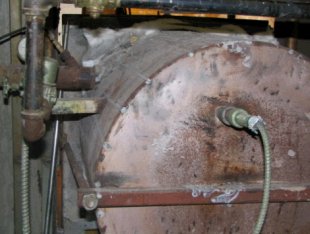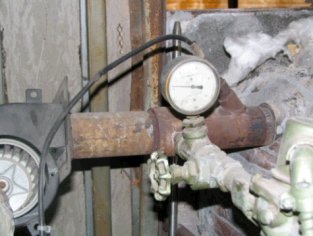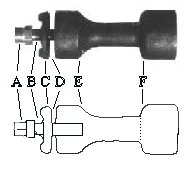|
Choices in Heating a Furnace/Glory Hole Rev. 3/27/94, 12/14/94,
7/18/95
ELECTRICITY VS GAS - For a furnace or glory hole for
glassblowing, a burner is normally used as it is much usually more
economical (when element cost is included) to use gas over
electricity. Those people using electricity to melt glass report
that the size of the furnace must be limited* and the elements
must often be replaced each time the furnace is shut down. Since
the temperature of melted glass is very near the upper limit* of
most electric heating material (except carbon arc which requires
such complicated hardware no artist uses it) or silicon oxide rod
which requires heavy power) the elements must be heavy and well
supported. Being heavy means that higher power and current must
be provided, adding to the expense.
[*I have learned recently that
Silicon Carbide elements, while suitable for high temps, require
adjustment of the voltage during the life of the elements,
increasing it to maintain power because the resistance changes so
much with aging and require lower voltage to start with (60 volts.) adding
complications, but becoming lower in cost and removing the size and temperature
limits.. 2006-05-30]
HEAT SUPPLIED - Burners supplying 90,000 Btu up to 350,000 Btu
are be used. A British thermal unit (Btu) is the amount of heat
needed to raise one pound of water one degree Fahrenheit. (about
1055 Joules in metric, 1055 watt-seconds) A common kitchen gas
burner is about 8,000 Btu, the large "Super Burner" on
our stove is 18,000. Turkey fryers blast off at 140,000-180,000 Btu. Wok
burners are 16,000-40,000 Btu. 2006-11-30
BASIC BURNER OVERVIEW - For the burner to work fuel must be
mixed with air. Since glass melting often takes place for months
on end, safety features must be considered, including dealing
with rare gas and more common electric power failures
Normally, the glory hole is heated only while the glass is
being worked and most often has manual controls, including a way
to produce a reducing atmosphere for striking, most often just
cutting off the air for a while.
Most of the considerations that apply to ceramics kilns also
apply to glass furnaces, such as spacing away from building walls.
But ceramic kilns are usually fired up to a temperature and then
shut down, while furnaces are often left at the holding
temperature (equal to cone 6 - 2100°F) for days and, when batch
is cooked, are maintained overnight at equivalent to cone 10-11 (2400-2500°F.)
|
|
COMBUSTION TRAIN - The entire flow of fuel to the burner, in a code approved
arrangement, is prescribed by one or more standards from National Fire
Protection Association (NFPA) industrial safety. Wading through the standards
involves eliminating a lot of stuff that applies only to relatively low
temperature burners - boilers and cooking ovens. Most suppliers of industrial
burners will work with the buyer to design a safe package, given the Btu
requirements, with the result costing $1500-2500 per burner train.
- WARNING-THIS IS NOT COMPLETE, DO NOT RELY ON IT FOR
DESIGN, IT IS AN OVERVIEW FOR GENERAL INFORMATION ONLY.
- At the fuel entry to the space (and/or at the tank) is a
manual cutoff valve which can easily be reached at all
times.
- At each branch to a burner there is a manual cutoff for
maintenance, etc. It is best if this is quickly
accessible. Some studios put in at the front of the hot
wall for quick access, especially for glory holes.
- For each burner there is a remotely driven (pneumatic or
electrical) valve that can provide cutoff of fuel. This
may be part of a valve that controls gas flow for
temperature control.
- There are one or more regulators that reduce pressure
from the main line to that useable by the burner.
- There may be a high and low pressure sensor to determine
if the gas is behaving.
- There may be gas/air mixer that proportions the two.
Mixers are available that once set, allow changing the
air flow and they will automatically keep the gas
properly flowing, about $200.
- At the burner, a flame sensor. This is totally vital
where the flame is shut off and turned back on later, as
in boilers, which require that all the gas be blown out
of the heating chamber before re-ignition is tried.
- At the burner, an igniter. Yes, a lot of furnaces and
glory holes are lighted with a burning piece of
newspaper, but if the furnace is to be left alone, it
probably has to have relighting ability.
- At the furnace, a temperature sensor. If the temperature
is to be controlled, a thermocouple or RTD is required.
It may also be used to determine whether a restart is
possible if an igniter has been left out of the setup. If
the furnace is hot enough to light the gas, the gas is
turned on, otherwise not, and the furnace chills down,
probably breaking the pot.
- A controller, to tie everything together. It is possible
to go both directions: a lesser setup where hard wired
sensors turn off valves or a greater setup where a
serious industrial controller handles the temperature and
the startup and the safety issues. A middle ground is one
simple controller that handles the temperature and
another fairly simple controller that handles safety and
restart.
|


 A wasp waist tube with the gas inlet appropriately placed drags
air proportionate to gas pressure. The wasp waist and gas velocity lowers air
pressure to drag more air in. Used with high pressure gas. No blower.
A wasp waist tube with the gas inlet appropriately placed drags
air proportionate to gas pressure. The wasp waist and gas velocity lowers air
pressure to drag more air in. Used with high pressure gas. No blower.